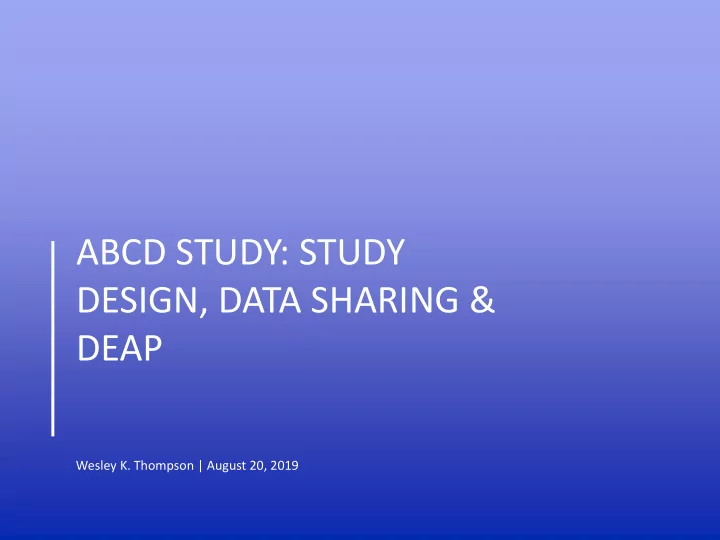

ABCD STUDY: STUDY DESIGN, DATA SHARING & DEAP Wesley K. Thompson | August 20, 2019
STUDY DESIGN
ABCD STUDY DESIGN • The complete collection of baseline data was released on the NIMH Data Archive (NDA) in March 2019. • Baseline data are assessed on 11,878 subjects at 21 sites around the country. • There are also follow-up assessments on a minority of these subjects. 3
ABCD data dictionary (release 2.0) 27,400 x 65,000
ABCD STUDY DESIGN (SHARED DATA IN 2.0) 5
ABCD STUDY DESIGN – DATA RELEASE SCHEDULE 6
ABCD STUDY DESIGN 7
Missing data ✓ I don’t know ✓ I don’t want to tell you ✓ Truly missing ✓ Messed up, never asked ✓ Lost in transmission ✓ We have answers but no participant ID ✓ Missingness by design (not missing) ✓ By event type (e.g. no imaging data at non-imaging events) ✓ New questionnaires/Variables are introduced – missing before date ✓ Missing because of branching logic
DATA SHARING
Shared data, opportunities/challenges • ABCD Policy: All data is shared on an ongoing basis – no holdout data. Any results published require a pre-release of that data. • Single channel for data release on National Data Archive. • Share standard results such as results from QC pipelines and derived scores is good • lower barrier for analysis entry • use the community to provide feedback • promote best practices • reduce researchers degrees of freedom • Requires additional resources for data curation, additional documentation, data sharing and communication towards the community. Exposes study to more challenging events.
A study centric view of data harmonization Harmonization of no interest Harmonization of value Name changes require extensive coupling Coding of complex data during acquisition to lists for quality assurance allow for linkage to external information sources Supported now by NDA: Supported by ABCD: • Alias fields in data dictionary • Use of RxNorm for medication inventory • Study specific download packages • Use of consistent names for brain ROIs
DEAP applications for specialized domains
DATA EXPLORATION AND ANALYSIS PORTAL (DEAP)
Data Exploration and Analysis Portal Web-based interface, cloud deployment NIMH’s NDA data sharing platform as data source Access to all ABCD measures shared in NDA17 Build-in nesting for multi-level covariates of choice Access to visualizations and statistical model summary
Shared ABCD data Available on National Data Archive (nda.nih.gov) requires signup and support from institution 11,875 participants data available since early 2019 3.2GB spreadsheet data (*.tsv) 23TB MRI (300Gb T1/T2) 65,000 measures per participant (>67% from imaging) Resources: Source code repositories - github.com/ABCD-STUDY/ Data Analysis and Exploration Portal
ABCD open science [1 Team, 15 members, 33 git repositories]
DEAP web-interface
Explore 44,000 ABCD measures
Visual sub-setting data exploration
Notebook style, user defined derived measures
Multilevel Data Analysis Multilevel statistical models for baseline data reflect the multilevel study design (GAMM4). x sfi are covariates (e.g., demographics) • z sfi are independent variables of interest • a s is a site-specific random effect • b f(s) is a family random effect nested within site • This model is extendable to non-normal outcomes (e.g., discrete, count variables).
ABCD STUDY DESIGN • Of these 11,875 subjects, family units include: • 8,150 singletons • 1,600 non-twin siblings • 2,100 twins (1,050 pairs) • 30 triplets (10 sets) 24
ABCD STUDY DESIGN • … Site 21 Site 1 MR 1 MR 2 Fam 1 Fam 2 Fam 3 Fam 4 S4 S5 S6 S3 S1 S2 25
Tutorial Mode on DEAP Not familiar with generalized additive mixed models for the analysis of longitudinal data in a multi-site project with a complex family structure? Deap provides a training-wheel mode with in-depth explanations on how to interpret your model.
Hypothesis Testing on DEAP Can changes in anxiety be explained by cognitive development scores measured in the picture vocabulary test, if one corrects for known covariates? C Regression model fit A Model specification B Data used in the model D Result tables / Model comparisons
Feature: Expert Mode Access to the (R) source code behind the GAMM4 model. Can be edited by the user and becomes part of a sharable resource for download and to other DEAP users.
DEAP Updates • Docker deployment of DEAP (github.com/ABCD-STUDY/DEAP). • Pre-registration workflow supporting model specification with variable selection and appropriate variable transformations. Text is provided for sampling, design, and analysis plan as well as for the analysis scripts. • Subset analysis of participants. • User defined derived variables with data dictionary entries and scoring algorithms (sharable). • Upcoming: • Allow for – additional projects shared on DEAP (NDA17, NDA18), – additional participants (add to our replace ABCD cohort)
Analyze
Analysis tutorial mode – expert commentary
Advanced Usage (Model Builder) A collaborative environment to integrate advanced statistical analysis features into ABCD. The model builder is software agnostic. R modules coexist next to python/pandas, Matlab. Data frames are used for inter-nodal communication. System provides computational cloud resources and each block can be extracted from the system (data and source-code) for documentation and offline analysis.
The building blocks for hypothesis testing Data flow graph (graphical programming) of the Model Builder on DEAP
ACKNOWLEDGEMENTS • The NIMH Data Archive (NDA) • Greg Farber • Rebecca Rosen • Brian Koser • Trevor Griffiths • NIH/NIDA • Gaya Dowling • Steve Grant • Elizabeth Hoffman • Vani Pariyadath • Anders Dale (PI of the ABCD DAIC: U24 DA041123) • The DAIC-DEAP Team: • Hauke Bartsch • Fangzhou Hu • Chase Reuter • ABCD Biostatistics Work Group 34
Recommend
More recommend